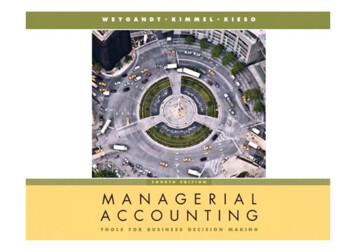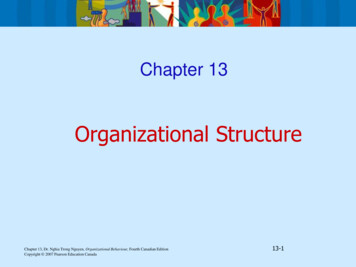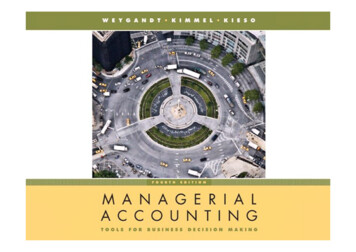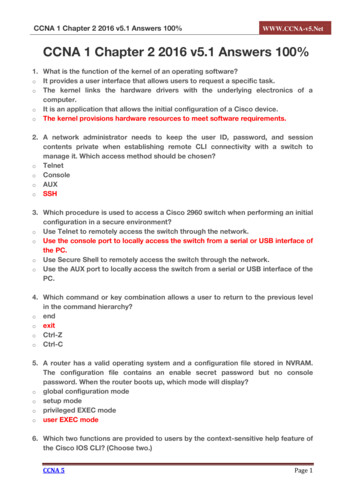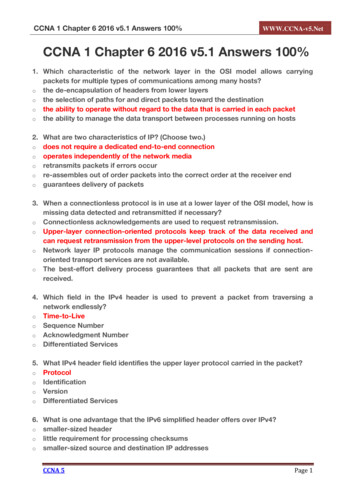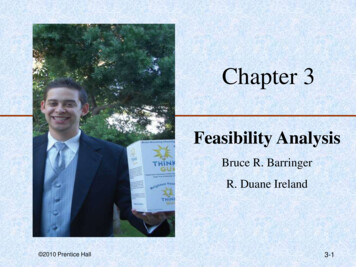
Transcription
Chapter 3Feasibility AnalysisBruce R. BarringerR. Duane Ireland 2010 Prentice Hall3-1
Chapter Objectives1 of 31. Explain what a feasibility analysis is and why it’simportant.2. Discuss the proper time to complete a feasibilityanalysis when developing an entrepreneurial venture.3. Describe the purpose of a product/service feasibilityanalysis and the two primary issues that a proposedbusiness should consider in this area.4. Explain a concept statement and its components.5. Describe the purpose of a buying intentions surveyand how it’s administered. 2010 Prentice Hall3-2
Chapter Objectives2 of 36. Explain the importance of library, Internet, andgumshoe research.7. Describe the purpose of industry/market feasibilityanalysis and the two primary issues to consider inthis area.8. Discuss the characteristics of an attractive industry.9. Describe the purpose of organizational feasibilityanalysis and list the two primary issues to considerin this area. 2010 Prentice Hall3-3
Chapter Objectives3 of 310. Explain the importance of financial feasibilityanalysis and list the most critical issues to considerin this area. 2010 Prentice Hall3-4
What Is Feasibility Analysis?Feasibility Analysis 2010 Prentice Hall Feasibility analysis is theprocess of determining whethera business idea is viable. It is the preliminary evaluationof a business idea, conductedfor the purpose of determiningwhether the idea is worthpursuing.3-5
When To Conduct a Feasibility Analysis Timing of Feasibility Analysis– The proper time to conduct a feasibility analysis is early inthinking through the prospects for a new business.– The thought is to screen ideas before a lot of resources arespent on them Components of a Properly Conducted FeasibilityAnalysis– A properly conducted feasibility analysis includes fourseparate components, as discussed in the following slides. 2010 Prentice Hall3-6
Feasibility AnalysisRole of feasibility analysis in developing business ideas. 2010 Prentice Hall3-7
Forms of Feasibility AnalysisProduct/Service FeasibilityIndustry/Target MarketFeasibilityOrganizational FeasibilityFinancial Feasibility 2010 Prentice Hall3-8
Outline for a Comprehensive FeasibilityAnalysis 2010 Prentice Hall3-9
Product/Service Feasibility Analysis1 of 2PurposeProduct/ServiceFeasibility Analysis 2010 Prentice Hall Is an assessment of the overallappeal of the product or servicebeing proposed. Before a prospective firm rushesa new product or service intodevelopment, it should be surethat the product or service is whatprospective customers want.3-10
Product/Service Feasibility Analysis2 of 2Components of product/servicefeasibility analysisProduct/ServiceDesirability 2010 Prentice HallProduct/ServiceDemand3-11
Product/Service Desirability1 of 3First, ask the following questions to determine the basicappeal of the product or service. Does it make sense? Is it reasonable? Is it something consumerswill get excited about? Does it take advantage of an environmental trend, solve aproblem, or take advantage of a gap in the marketplace? Is this a good time to introduce the product or service to themarket? Are there any fatal flaws in the product or service’s basic designor concept? 2010 Prentice Hall15-12
Product/Service Desirability2 of 3 Second, Administer a Concept Test– A concept statement should be developed.– A concept statement is a one page description of a business,that is distributed to people who are asked to providefeedback on the potential of the business idea.– The feedback will hopefully provide the entrepreneur A sense of the viability or the product or service idea. Suggestions for how the idea can be strengthened or “tweaked”before proceeding further. 2010 Prentice Hall3-13
Product/Service Desirability3 of 3New VentureFitness Drink’sConcept Statement 2010 Prentice Hall3-14
Product/Service Demand1 of 6 Product/Service Demand– Their are two steps to assessing product/service demand.– Step 1: Administer a Buying Intentions Survey– Step 2: Conduct library, Internet, and Gumshoe research 2010 Prentice Hall3-15
Product/Service Demand2 of 6 Buying Intentions Survey– Is an instrument that is used to gauge customer interest in aproduct or service.– It consists of a concept statement or a similar description ofa product or survey with a short survey attached to gaugecustomer interest.– Internet sites like SurveyMonkey make administering abuying intentions survey easy and affordable. 2010 Prentice Hall3-16
Product/Service Demand3 of 6 2010 Prentice Hall3-17
Product/Service Demand4 of 6 Library, Internet, and Gumshoe Research– The second way to assess the demand for a product orservice is by conducting library, Internet, and gumshoeresearch.– Reference librarians can often point you towards resourcesto help you investigate a business idea, such as industryspecific trade journal and industry reports.– Internet searches can often yield important informationabout the potentially viability of a product or service idea. 2010 Prentice Hall3-18
Product/Service Demand5 of 6ExplanationGumshoe Research 2010 Prentice Hall A gumshoe is a detective or aninvestigator that scrounges aroundfor information or clues whereverthey can be found. Be a gumshoe. Ask peoplewhat they think about your productor service idea. If your idea is tosell educational toys, spend a weekvolunteering at a day care centerand watch how children interactwith toys.3-19
Product/Service Demand6 of 6 One of the most effectivethings an entrepreneurcan do to conduct athorough product/servicefeasibility analysis is tohit the streets and talk topotential customers. This potential entrepreneuris administering a surveyabout a new product idea. 2010 Prentice Hall3-20
Industry/Target Market Feasibility Analysis1 of 2PurposeIndustry/Target MarketFeasibility Analysis 2010 Prentice Hall Is an assessment of the overallappeal of the industry and thetarget market for the proposedbusiness. An industry is a group of firmsproducing a similar product orservice. A firm’s target market is thelimited portion of the industry itplans to go after.3-21
Industry/Target Market Feasibility Analysis2 of 2Components of industry/target marketfeasibility analysisIndustry Attractiveness 2010 Prentice HallTarget MarketAttractiveness3-22
Industry Attractiveness1 of 2 Industry Attractiveness– Industries vary in terms of their overall attractiveness.– In general, the most attractive industries have thecharacteristics depicted on the next slide.– Particularly important—the degree to which environmentaland business trends are moving in favor rather than againstthe industry . 2010 Prentice Hall3-23
Industry Attractiveness2 of 2 2010 Prentice Hall3-24
Target Market Attractiveness Target Market Attractiveness– The challenge in identifying an attractive target market is tofind a market that’s large enough for the proposed businessbut is yet small enough to avoid attracting largercompetitors.– Assessing the attractiveness of a target market is tougherthan an entire industry.– Often, considerably ingenuity must be employed to findinginformation to assess the attractiveness of a specific targetmarket. 2010 Prentice Hall3-25
Organizational Feasibility Analysis1 of 2PurposeOrganizational FeasibilityAnalysis 2010 Prentice Hall Is conducted to determinewhether a proposed business hassufficient management expertise,organizational competence, andresources to successfully launcha business. Focuses on non-financial resources.3-26
Organizational Feasibility Analysis2 of 2Components of organizationalfeasibility analysisManagement Prowess 2010 Prentice HallResource Sufficiency3-27
Management Prowess1 of 2 Management Prowess– A firm should candidly evaluate the prowess, or ability, ofits management team to satisfy itself that management hasthe requisite passion and expertise to launch the venture.– Two of the most important factors in this area are: The passion that the solo entrepreneur or the founding team has forthe business idea. The extent to which sole entrepreneur or the founding teamunderstands the markets in which the firm will participate. 2010 Prentice Hall3-28
Management Prowess2 of 2 An indication of passionis the willingness of anew venture team tocomplete a comprehensivefeasibility analysis. 2010 Prentice Hall3-29
Resource Sufficiency1 of 2 Resource Sufficiency– This topic pertains to an assessment of whether anentrepreneur has sufficient resources to launch theproposed venture.– To test resource sufficiency, a firm should list the 6 to 12most critical nonfinancial resources that will be needed tomove the business idea forward successfully. If critical resources are not available in certain areas, it may beimpractical to proceed with the business idea. 2010 Prentice Hall3-30
Resource Sufficiency2 of 2Examples of nonfinancial resources that may be criticalto the successful launch of a new business Availability ofaffordable office or lab space. Likelihood of local and state government support of the business. Quality of the labor pool available. Proximity to key suppliers and customers. Willingness of high quality employees to join the firm. Likelihood of establishing favorable strategic partnerships. Proximity to similar firms for the purpose of sharing knowledge. Possibility of obtaining intellectual property protection in key areas. 2010 Prentice Hall3-31
Financial Feasibility Analysis1 of 2PurposeFinancial FeasibilityAnalysis 2010 Prentice Hall Is the final component of acomprehensive feasibility analysis. A preliminary financial assessmentis sufficient.3-32
Financial Feasibility Analysis2 of 2Components of financialfeasibility analysisTotal Start-Up CashNeededFinancial Performance ofSimilar BusinessesOverall FinancialAttractiveness of theProposed Venture 2010 Prentice Hall3-33
Total Start-Up Cash Needed Total Start-Up Cash Needed– The first issues refers to the the total cash needed to preparethe business to make its first sale.– An actual budget should be prepared that lists all theanticipated capital purchases and operating expensesneeded to generate the first 1 in revenues.– The point of this exercise is to determine if the proposedventure is realistic given the total start-up cash needed. 2010 Prentice Hall3-34
Financial Performance of SimilarBusinesses Financial Performance of Similar Businesses– Estimate the proposed start-up’s financial performance bycomparing it to similar, already established businesses.– There are several ways to doing this, all of which involve alittle ethical detective work. First, there are many reports available, some for free and some thatrequire a fee, offering detailed industry trend analysis and reportson thousands of individual firms. Second, simple observational research may be needed. Forexample, the owners of New Venture Fitness Drinks could estimatetheir sales by tracking the number of people who patronize similarrestaurants and estimating the average amount each customerspends. 2010 Prentice Hall3-35
Overall Financial Attractiveness of theProposed Venture1 of 2 Overall Financial Attractiveness of the ProposedInvestment– A number of other financial factors are associated withpromising business startups.– In the feasibility analysis stage, the extent to which abusiness opportunity is positive relative to each factor isbased on an estimate rather than actual performance.– The table on the next slide lists the factors that pertain tothe overall attractiveness of the financial feasibility of thebusiness idea. 2010 Prentice Hall3-36
Overall Financial Attractiveness of theProposed Venture2 of 2Financial Factors Associated With Promising BusinessOpportunities Steady and rapid growth in sales during the first 5 to 7 years in a clearlydefined market niche. High percentage of recurring revenue—meaning that once a firm wins aclient, the client will provide recurring sources of revenue. Ability to forecast income and expenses with a reasonable degree ofcertainty. Internally generated funds to finance and sustain growth. Availability of an exit opportunity for investors to convert equity to cash. 2010 Prentice Hall3-37
First Screen First Screen– Shown in Appendix 3.1, is a template for completing afeasibility analysis.– It’s called “First Screen” because it’s a tool that can beused in the initial pass at determining the feasibility of abusiness idea.– If a business idea cuts muster at this stage, the next step isto complete a business plan. 2010 Prentice Hall3-38
All rights reserved. No part of this publication may be reproduced,stored in a retrieval system, or transmitted, in any form or by anymeans, electronic, mechanical, photocopying, recording, or otherwise,without the prior written permission of the publisher. Printed in theUnited States of America.Copyright 2010 Pearson Education, Inc.publishing as Prentice Hall 2010 Prentice Hall
06.07.2017 · Organizational Feasibility Analysis 1 of 2 Organizational Feasibility Analysis Purpose Is conducted to determine whether a proposed business has sufficient management expertise, organizational competence, and resources to successfully launch a business. Focuses on non-financial resources. 2010 Prentice Hall 3-27 Organizational Feasibility Analysis 2 of 2 Components of organizational .






